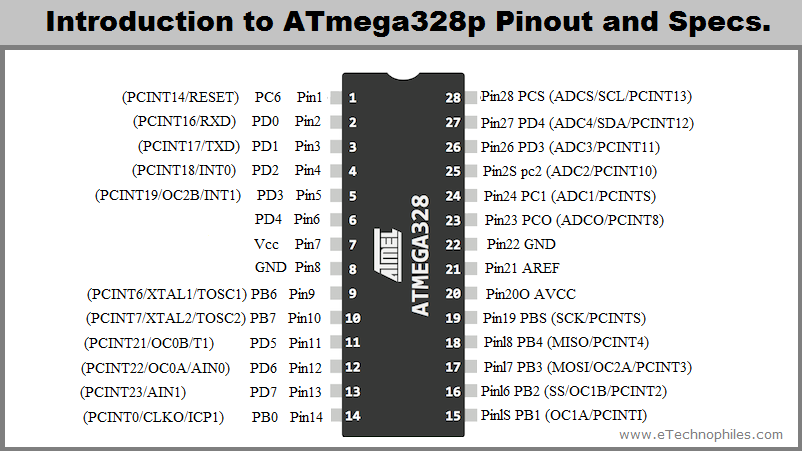Atmega328p has a low-power 8 bit atmel microcontroller and a high-performance controller from a microchip. It is based on AVR RISC architecture. Of all the AVR controllers used in ARDUINO brands, this one is the most popular.
It is similar to all other controllers. The controller executes the program it has been provided with instantly. When programming is not being used, the controller stays put doing nothing. To program the controller, you have to write the relevant program file in the Atmega328p flash memory.
Once the controller receives the instructions, it executes the code and gives an appropriate response.
Atmega 328p datasheet
According to its datasheet, some of the main specs of the controller are:
- A CPU of 8-bit AVR
- Has 23 programmable I/O lines
- Six channels of ADC module
- 10-bit resolution ADC
- 6 PWM channels
- 32Kbytes on the flash memory
- Programmable Watchdog timer with a separate On-chip oscillator
- Operating temperature of -40oC to +1050C
- CPU speed of 1MIPS for 1MHz
The following are the key application areas for the controller:
- Peripheral interface system
- Display units
- Motor control systems
- Digital data processing
- Industrial control systems
- Analog signal manipulations and measuring
- SMPS and power regulation systems
- Embedded systems like vending machines and coffee machine
- Used in ARDUINO UNO, ARDUINO NANO, and ARDUINO MICRO boards
Atmega328p pinout
Atmega328p has 28 pins. Most of the pins have more than one function. The second one, for example, is used for serial communication and can be used for programming as well. The ground pin for the controller is pin 22.
Look at the pinout diagram below.

Atmega328p Equivalents and Replacement Details
Atmega328p is a Low Power 8 Bit Atmel Microcontroller. It’s equivalents are atmega8535, atmega32 and atmega16. Atmega8 can be used as a replacement for the controller. Most of the equivalents of the controller use Arduino Nano and Arduino Uno boards so that they can be interchanged with that of Atmega328p.




